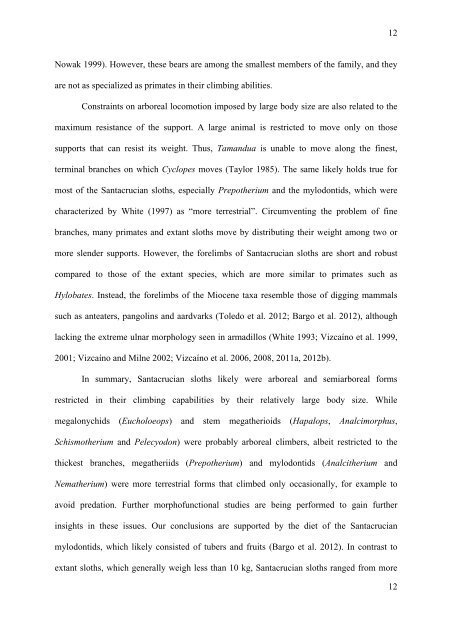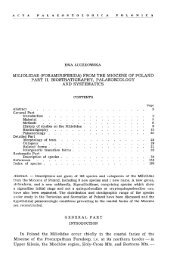Mass estimation in fossil sloths (Xenarthra, Folivora) from the Early ...
Mass estimation in fossil sloths (Xenarthra, Folivora) from the Early ...
Mass estimation in fossil sloths (Xenarthra, Folivora) from the Early ...
You also want an ePaper? Increase the reach of your titles
YUMPU automatically turns print PDFs into web optimized ePapers that Google loves.
Nowak 1999). However, <strong>the</strong>se bears are among <strong>the</strong> smallest members of <strong>the</strong> family, and <strong>the</strong>y<br />
are not as specialized as primates <strong>in</strong> <strong>the</strong>ir climb<strong>in</strong>g abilities.<br />
Constra<strong>in</strong>ts on arboreal locomotion imposed by large body size are also related to <strong>the</strong><br />
maximum resistance of <strong>the</strong> support. A large animal is restricted to move only on those<br />
supports that can resist its weight. Thus, Tamandua is unable to move along <strong>the</strong> f<strong>in</strong>est,<br />
term<strong>in</strong>al branches on which Cyclopes moves (Taylor 1985). The same likely holds true for<br />
most of <strong>the</strong> Santacrucian <strong>sloths</strong>, especially Prepo<strong>the</strong>rium and <strong>the</strong> mylodontids, which were<br />
characterized by White (1997) as “more terrestrial”. Circumvent<strong>in</strong>g <strong>the</strong> problem of f<strong>in</strong>e<br />
branches, many primates and extant <strong>sloths</strong> move by distribut<strong>in</strong>g <strong>the</strong>ir weight among two or<br />
more slender supports. However, <strong>the</strong> forelimbs of Santacrucian <strong>sloths</strong> are short and robust<br />
compared to those of <strong>the</strong> extant species, which are more similar to primates such as<br />
Hylobates. Instead, <strong>the</strong> forelimbs of <strong>the</strong> Miocene taxa resemble those of digg<strong>in</strong>g mammals<br />
such as anteaters, pangol<strong>in</strong>s and aardvarks (Toledo et al. 2012; Bargo et al. 2012), although<br />
lack<strong>in</strong>g <strong>the</strong> extreme ulnar morphology seen <strong>in</strong> armadillos (White 1993; Vizcaíno et al. 1999,<br />
2001; Vizcaíno and Milne 2002; Vizcaíno et al. 2006, 2008, 2011a, 2012b).<br />
In summary, Santacrucian <strong>sloths</strong> likely were arboreal and semiarboreal forms<br />
restricted <strong>in</strong> <strong>the</strong>ir climb<strong>in</strong>g capabilities by <strong>the</strong>ir relatively large body size. While<br />
megalonychids (Eucholoeops) and stem mega<strong>the</strong>rioids (Hapalops, Analcimorphus,<br />
Schismo<strong>the</strong>rium and Pelecyodon) were probably arboreal climbers, albeit restricted to <strong>the</strong><br />
thickest branches, mega<strong>the</strong>riids (Prepo<strong>the</strong>rium) and mylodontids (Analci<strong>the</strong>rium and<br />
Nema<strong>the</strong>rium) were more terrestrial forms that climbed only occasionally, for example to<br />
avoid predation. Fur<strong>the</strong>r morphofunctional studies are be<strong>in</strong>g performed to ga<strong>in</strong> fur<strong>the</strong>r<br />
<strong>in</strong>sights <strong>in</strong> <strong>the</strong>se issues. Our conclusions are supported by <strong>the</strong> diet of <strong>the</strong> Santacrucian<br />
mylodontids, which likely consisted of tubers and fruits (Bargo et al. 2012). In contrast to<br />
extant <strong>sloths</strong>, which generally weigh less than 10 kg, Santacrucian <strong>sloths</strong> ranged <strong>from</strong> more<br />
12<br />
12
















